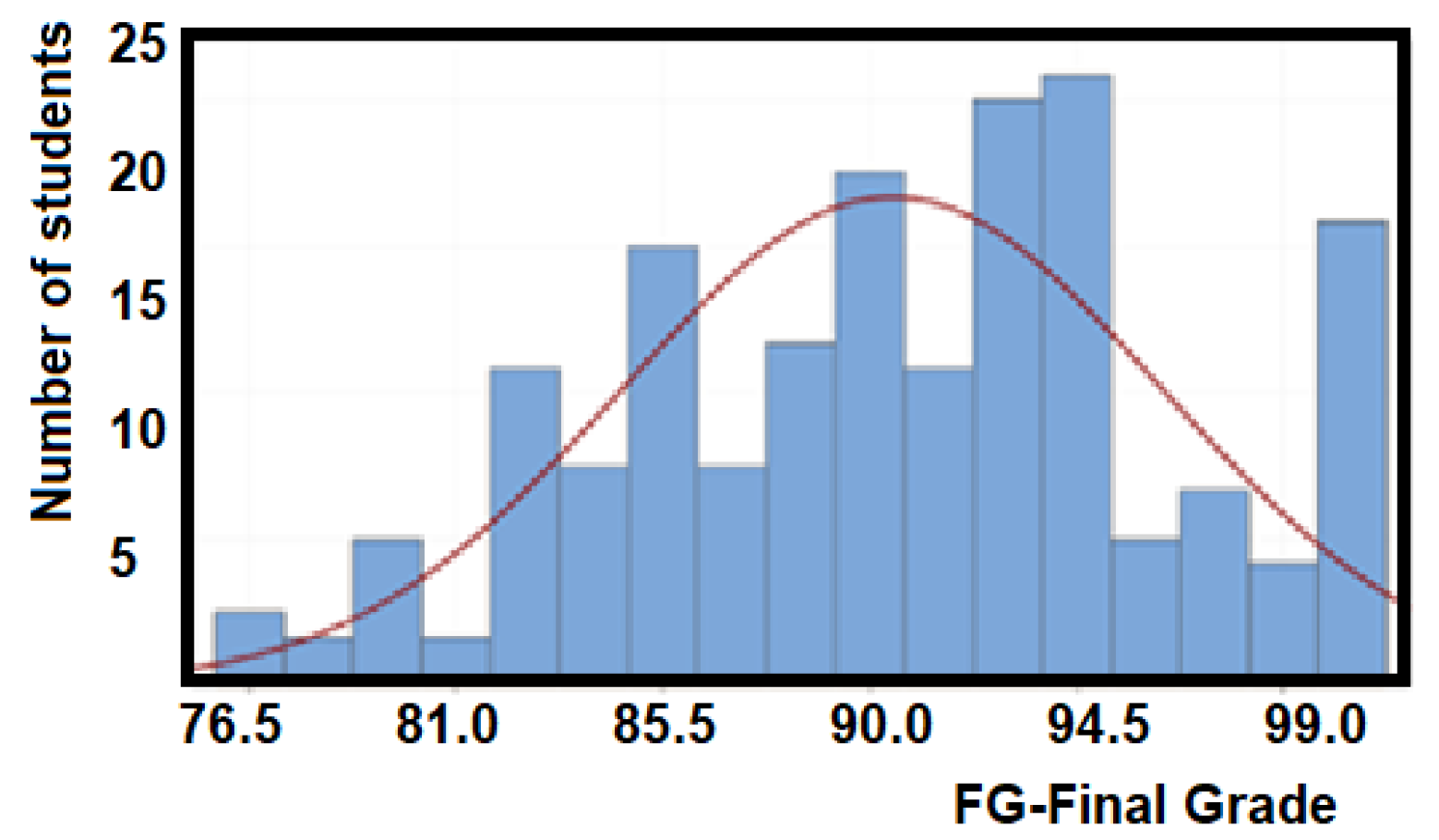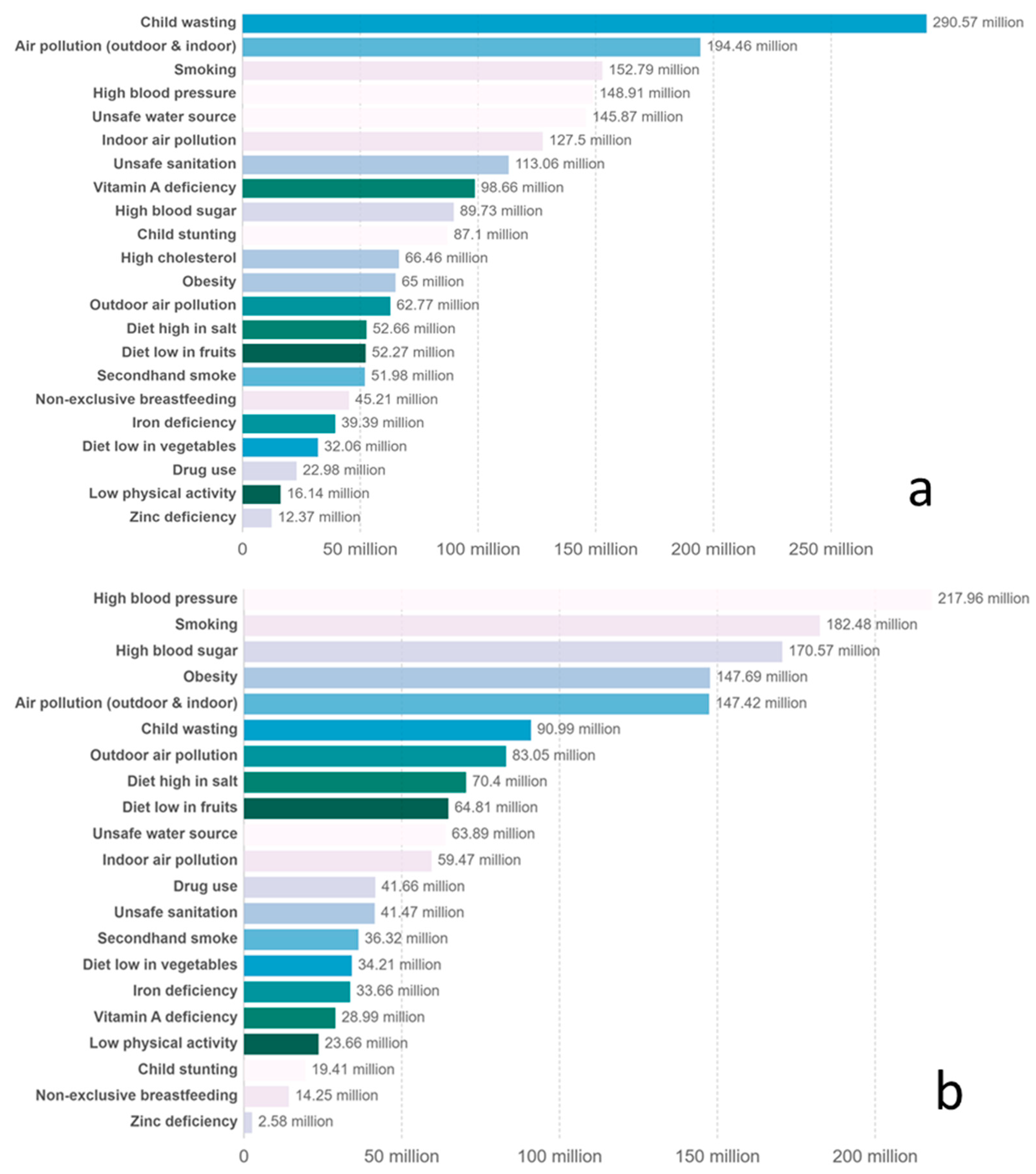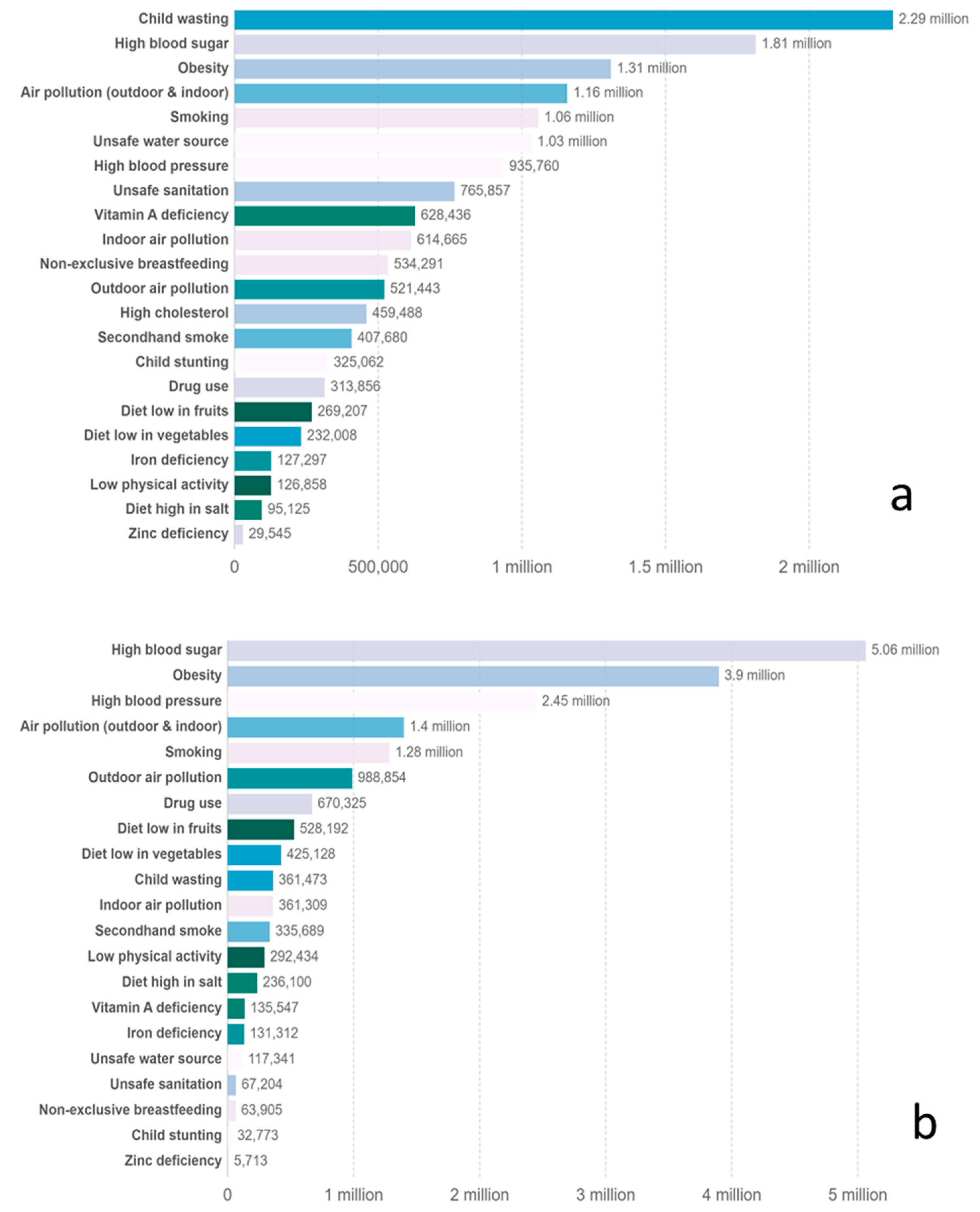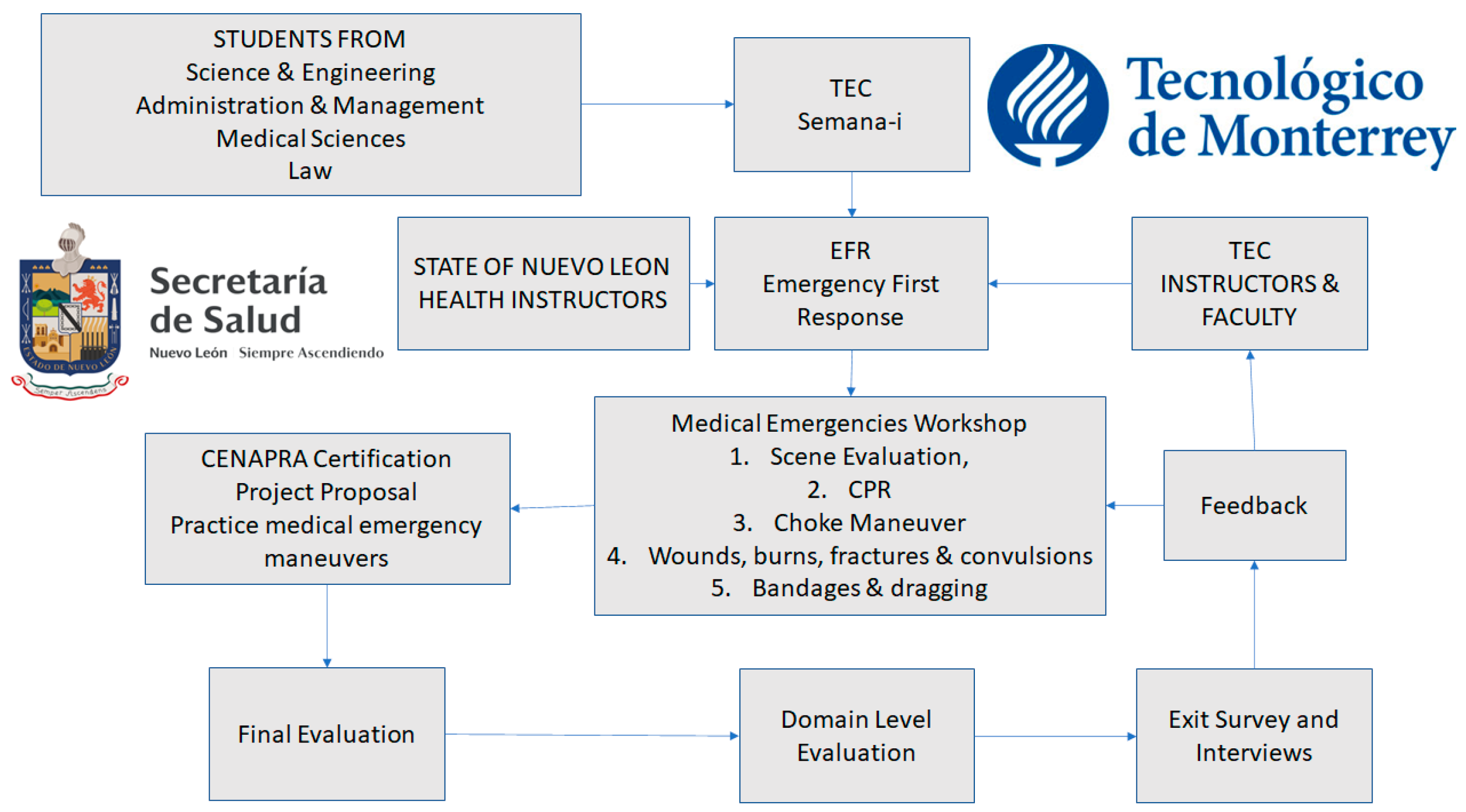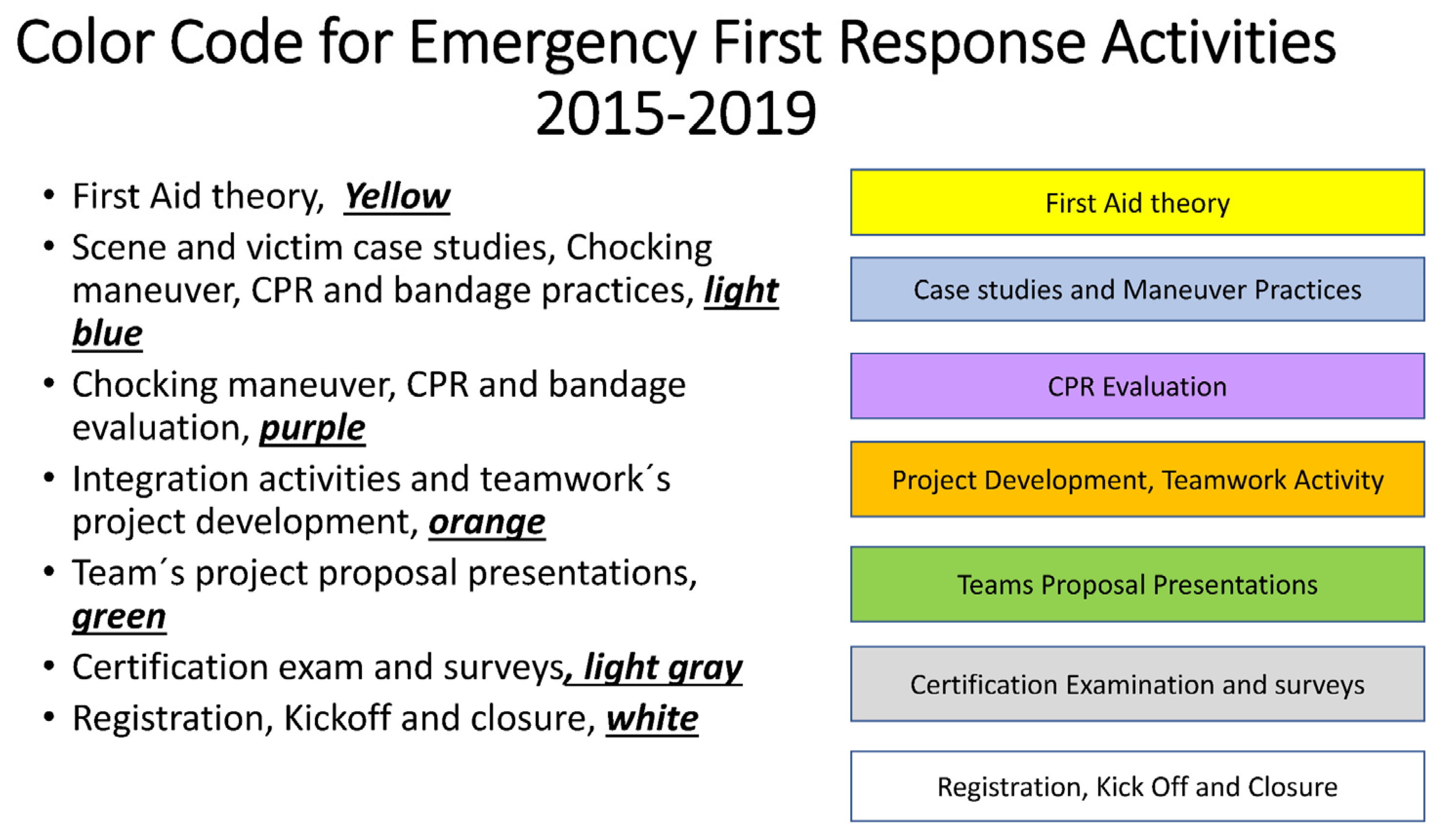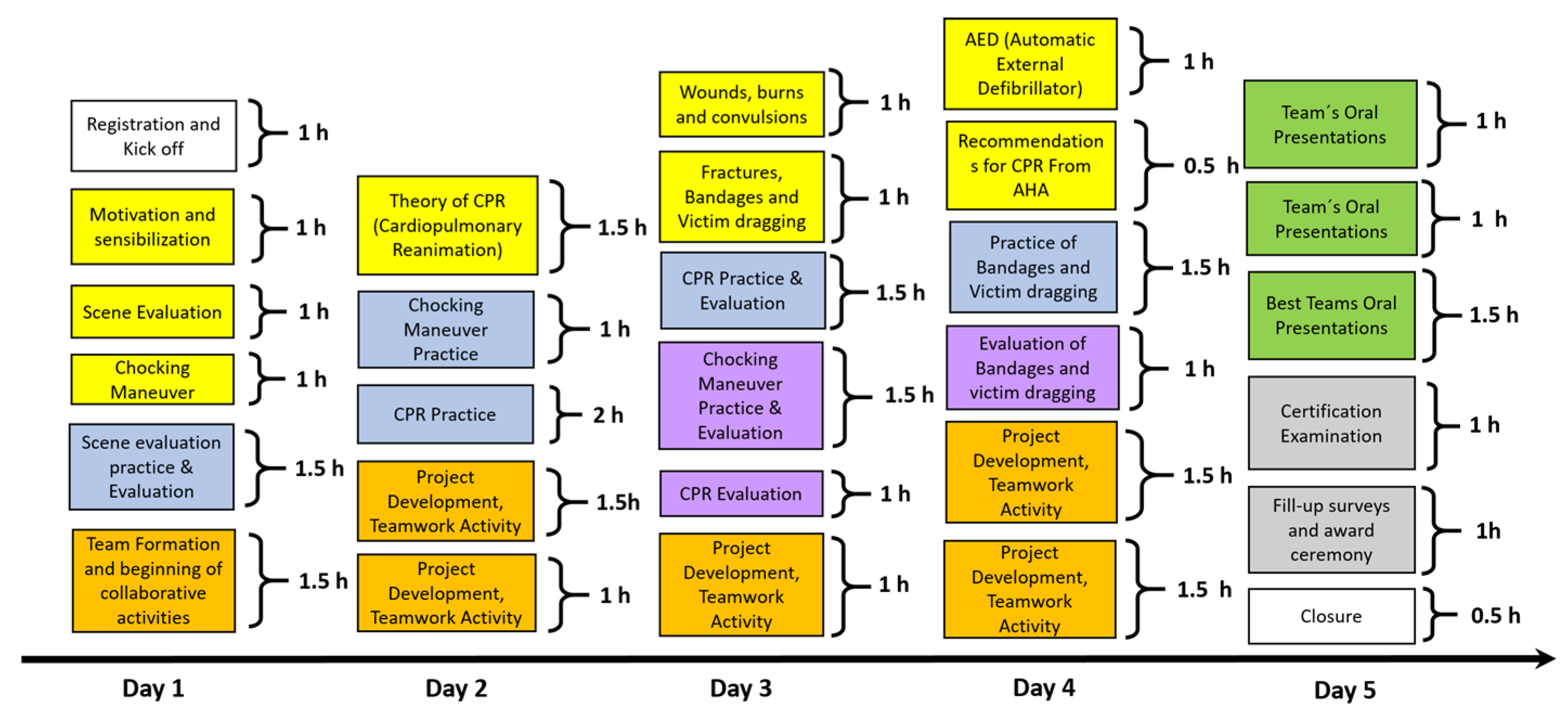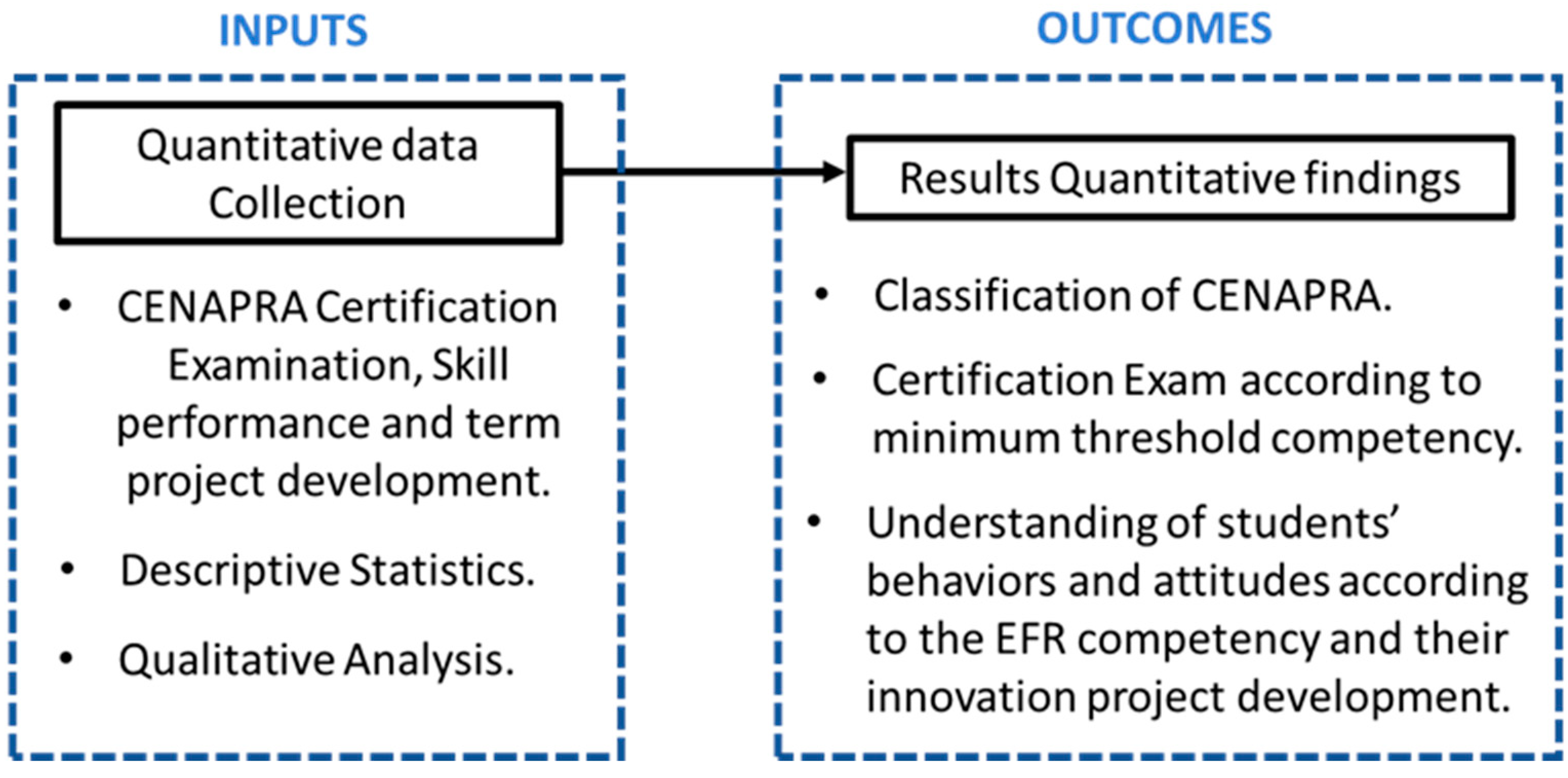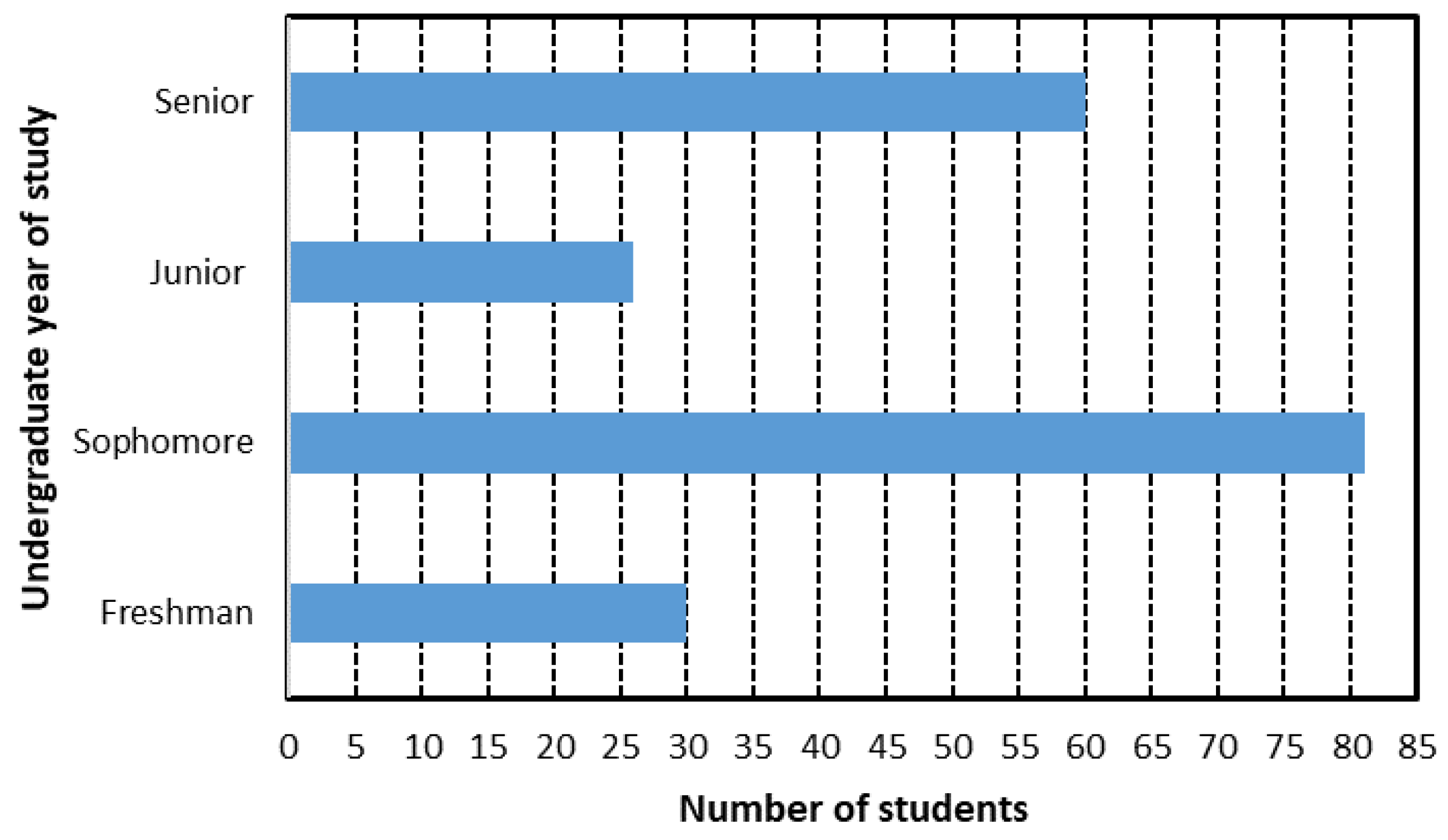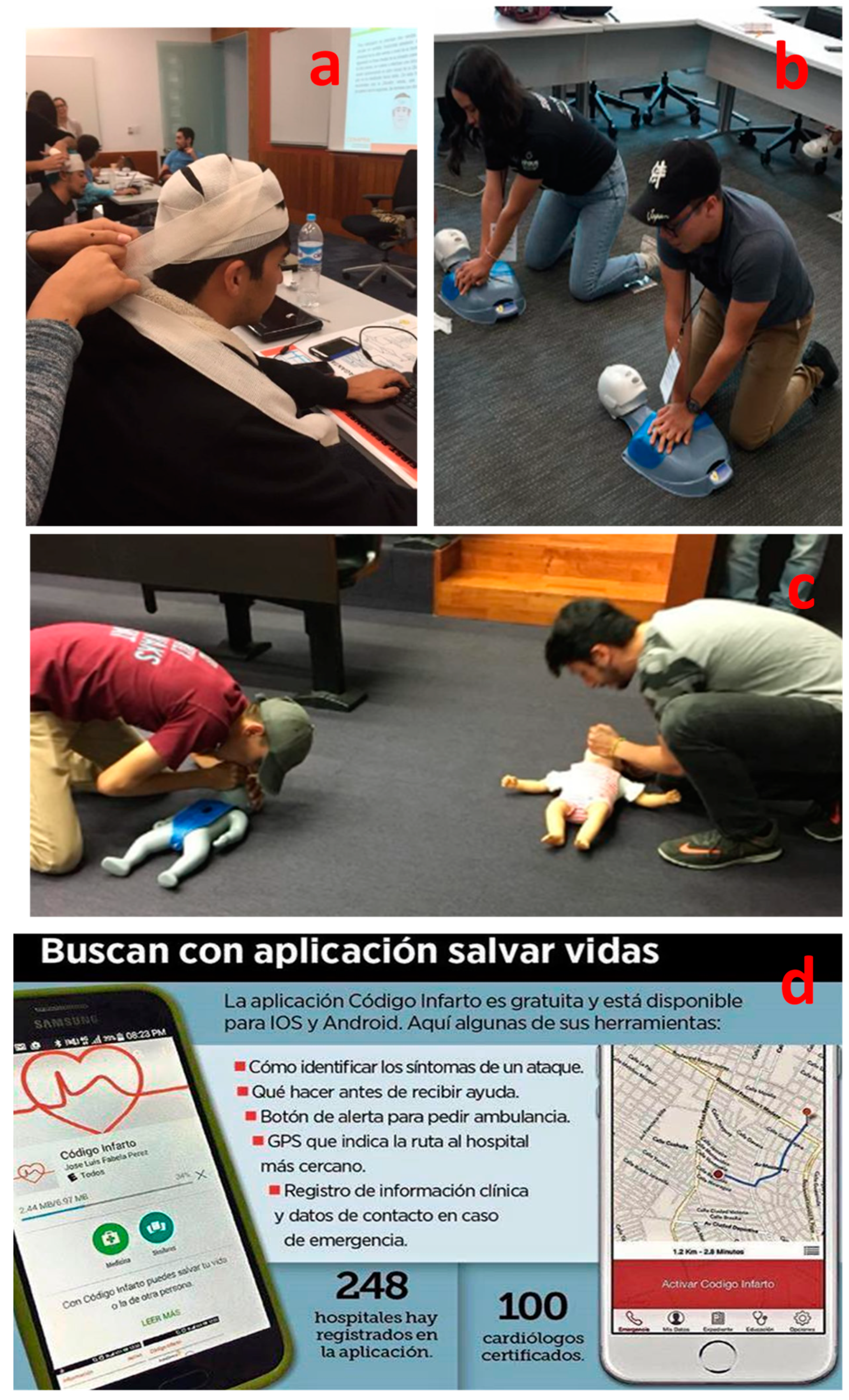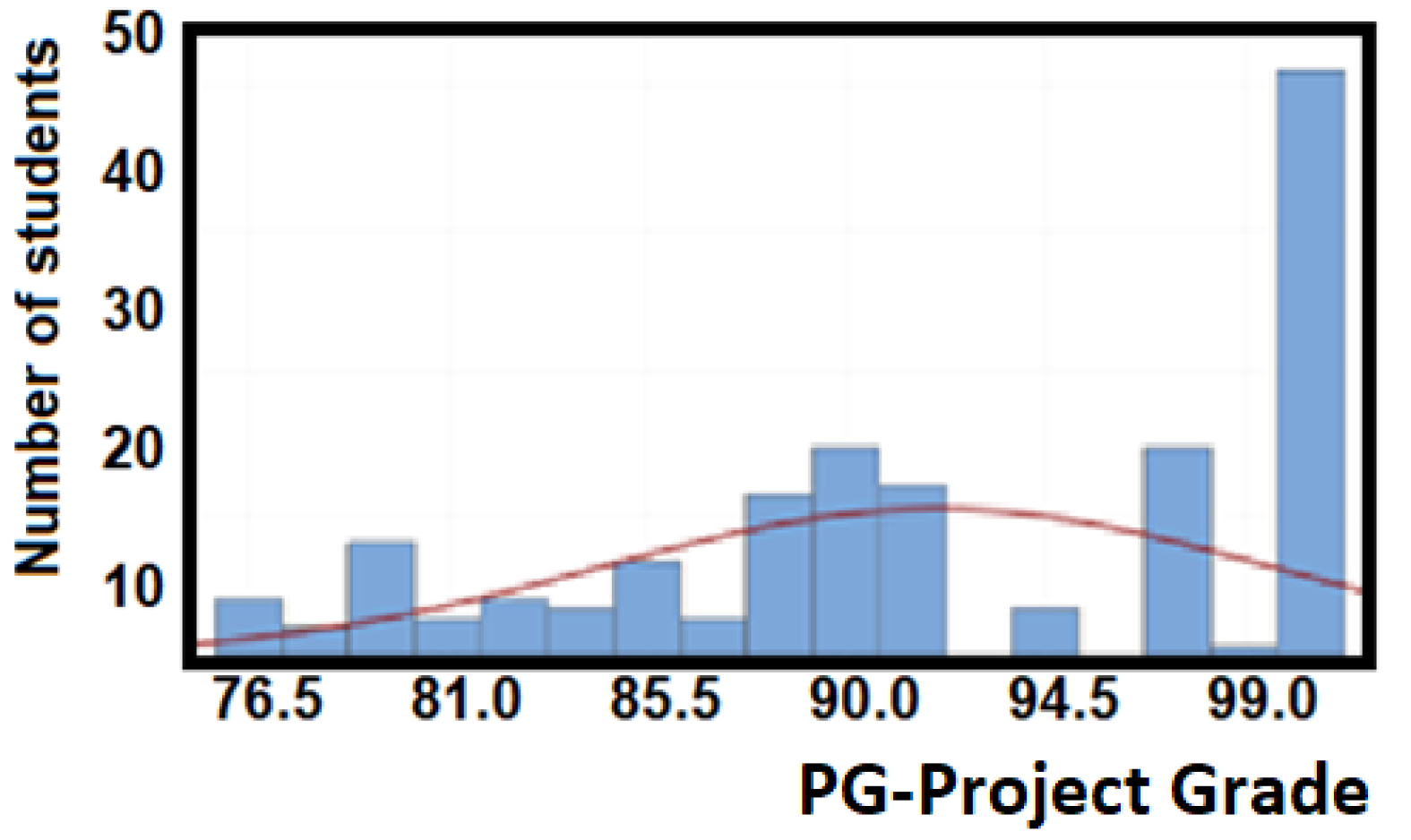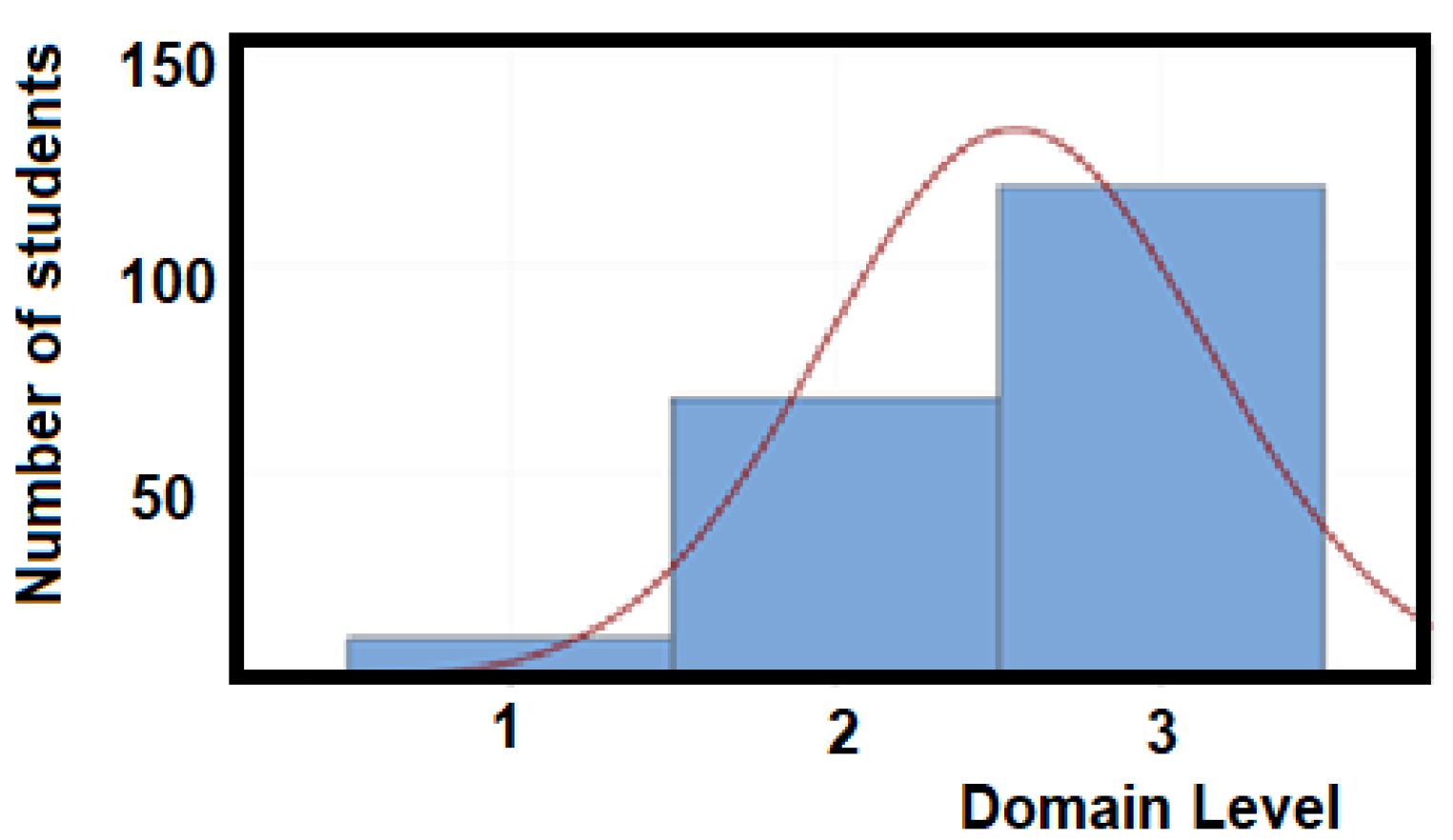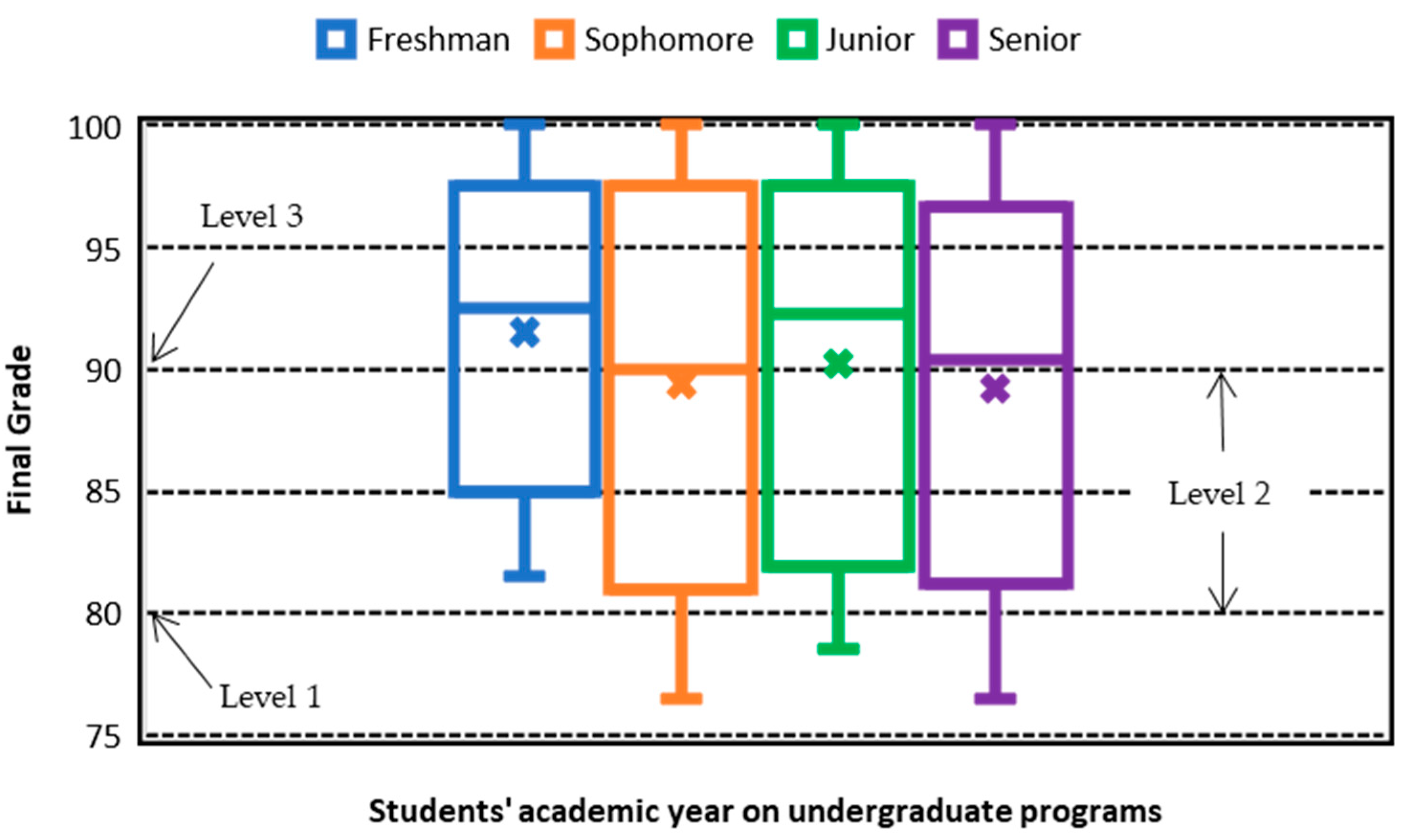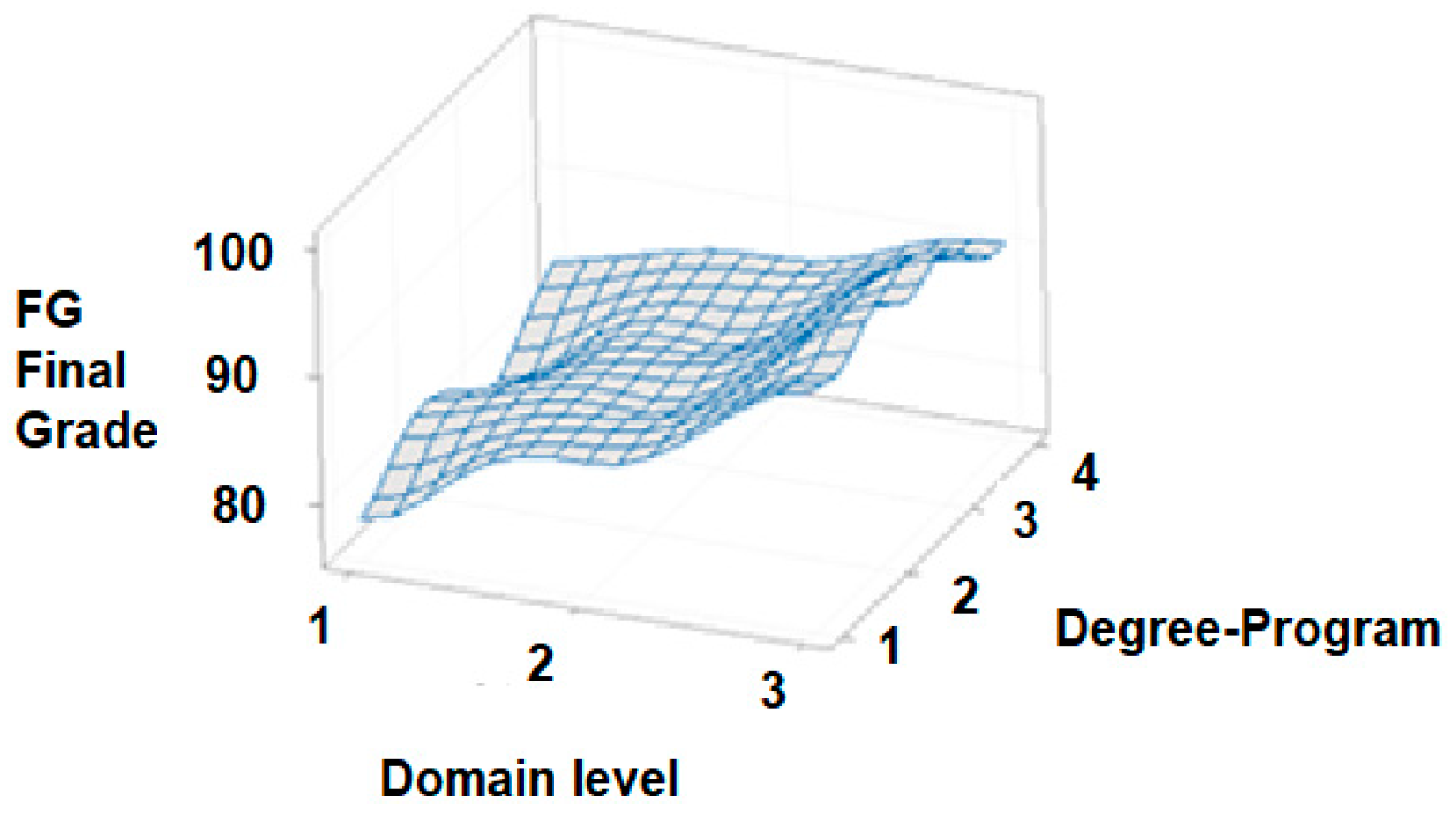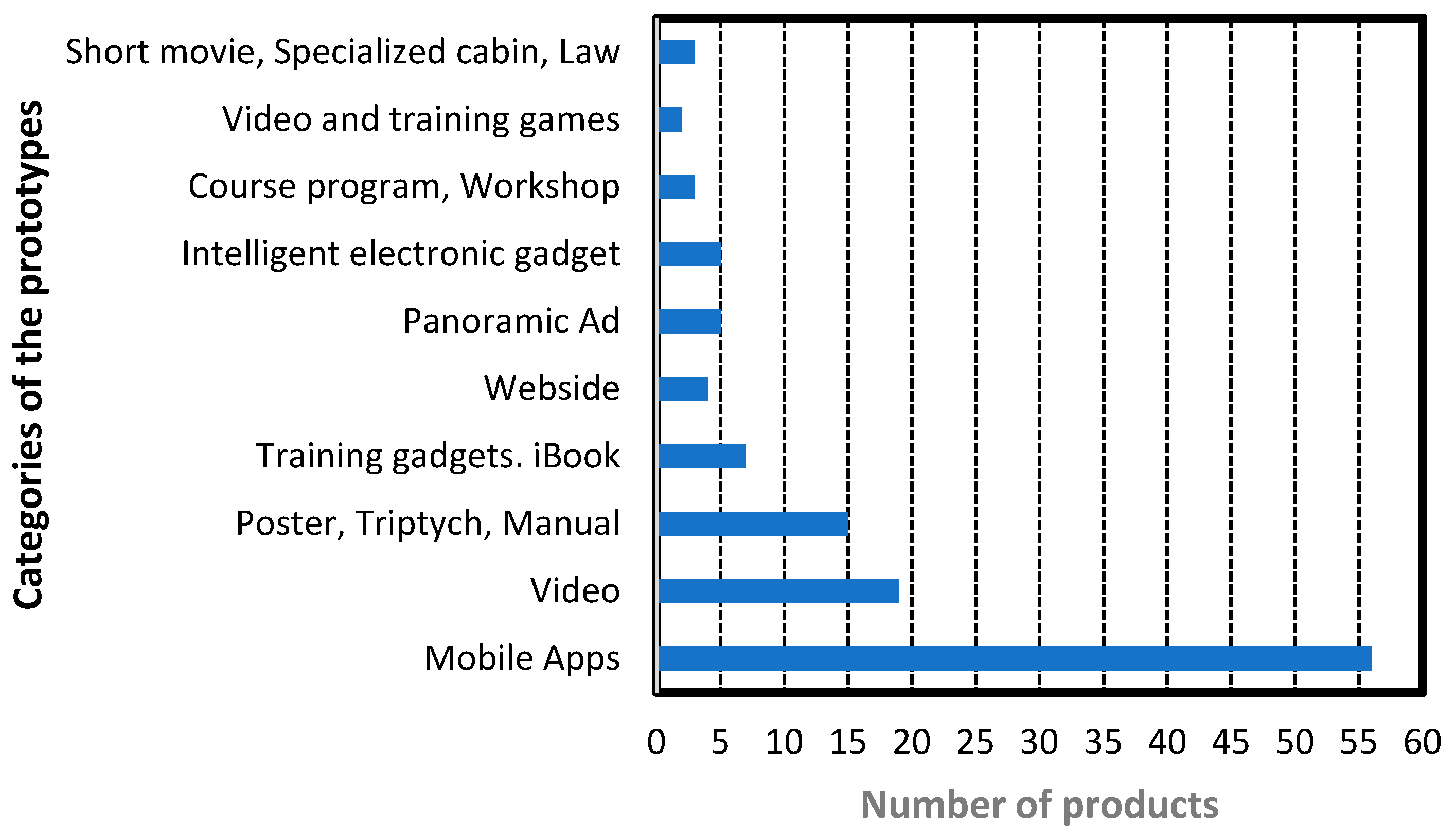1. Introduction
Studies have been reported to describe improvements for teaching in emergency services in students in medical areas from different approaches. Some examples are: education for mental health in medical services [
1]; analysis of teaching in online courses for knowledge transfer [
2]; characterizing the knowledge through lay about intervening in symptoms of acute myocardial infarction [
3]; evaluating the competencies in emergency management of two groups of medical students, where one of them received training in emergency cases and the other group did not [
4]; psychometric evaluations of paramedics as a respective study to analyze the effectiveness in educators [
5]; evaluation of the impact of gender on students to measure motivation and learning in students through a digital game teaching content-based emergency first aid [
6]; evaluating whether first aid training gives students greater confidence to act in emergencies [
7].
Furthermore, the development of evaluations for emergency medical services to professionals has been explored, in order to detect whether the professionals have knowledge regarding how to proceed in cases of incidents where safety knowledge is required, in places where the use of chemistry is developed [
8]. Likewise, evaluations have been implemented in short courses of emergency care by technicians in prehospital services [
9]; Studies have been carried out documenting the experiences of preceptors who supervise students in their clinical practices in emergency medical services [
10]. Similarly, the usefulness of mentoring has been examined in two ways; adaptively based on performance, or based on behavior in smart tutoring for emergency medical services courses [
11]. Moreover, comparative studies of teaching methods have been carried out either through a traditional course or workshops about medical emergencies for medical students [
12]. Literature review studies have even been reported in international training courses for emergency medical services to synthesize the central elements in order to form a curricular program [
13].
With another approach, there is a study to evaluate the content of tweets with the hashtag #FOAMems, since prehospital care physicians and paramedics use this resource as a way of continuing education and for international collaboration [
14]. In addition, an analysis of surveys of emergency medical technicians and medical directors has been reported to review the most important basic competencies for the levels of training in medical emergencies in Taiwan [
13]. Likewise, a study has been reported to give recommendations on modular training for various educational institutions in the medical area for emergency first aid training [
15].
An important area not contemplated in emergency medical services is when it is required to provide massive training for all health professionals; this should be a priority when cases of natural disasters occur, and in that sense a training study of emergency medical services was carried out through lectures to medical students for two weeks [
16]. In another study, the implementation of a drill was reported where mass victims were contemplated. In the activity, nursing students, emergency medical technicians, policemen and firefighters were trained in medical emergency services [
17]. To maintain certification, first responders must take biennial refresher courses. The certification is granted by the National Registry of Emergency Medical Technicians (NREMT). Such first responder courses are provided by community colleges and/or online education institutions such as Kaplan University, ITT Technical Institute, or Azusa Pacific University.
From the studies, there is an interest in increasing training in emergency medical services for health professionals, where natural disasters that can often be man-made are contemplated. This is due to an increase in demography, which consequently has increased industrialized activity, and the extension of urban areas that cause global warming with this activity. Some examples of these cases can be observed in several earthquakes that have struck Mexico City in 1985 and 2017. Likewise, in 1988, there were tornados in central Florida, or in 2012 and 2017 there were hurricanes with a significantly devastating effect in Louisiana, Florida, and Puerto Rico, respectively. As a result, there are quite a few documented initiatives for creating a community conscience of first responders, even though the evidence has shown that when an emergency, pandemic conditions (such as COVID-19), or disaster strikes, victims and volunteers act as the true first responders. In all cases, ad-hoc citizen groups rescue other people from the rubble and create disaster relief centers, among other emergency response activities.
In addition to this problem, it is in the workplace and in the time invested in transportation that most of the injuries are presented in people.
Appendix A of this work presents more details of the global crisis in occupational safety at work worldwide and in Mexico. Therefore, the need to acquire knowledge of EFR is observed regardless of whether people are health professionals. Unfortunately, the available literature related to EFR studies has primarily been focused on training health professionals, and thus ignoring the rest of the society; for instance, among the few studies is one which assesses the attitudes and knowledge of cardio-pulmonary-reanimation (CPR) course to improve prehospital survival rates where high school students aged 15 to 16 years were trained in 18 schools in Hong Kong [
18]. Additionally, there is a qualitative study of emergency first aid training in members of communities living in remote areas to generate their confidence and self-efficacy in emergency situations [
19]. Another study evaluated the effectiveness of the cabin crew in medical emergency events on flights of an airline in Greece for a period of (2014–2018) [
20].
As a matter of fact, a commitment has been made by the countries belonging to the United Nations to work on the 2030 agenda of the sustainable development goals (SDG). For this, universities have begun to adapt their study plans to address the 17 objectives of the sustainable development goals, some examples are described here [
21,
22,
23,
24,
25]. Among the 17 objectives, objective 3, is “
Health and well-being”. In particular, objective 3 presents various targets to be met that are presented directly associated with the issue of first aid treatment or medical emergency services that are listed below:
Target 1: Reduce mortality from non-communicable diseases and promote mental health.
Target 2: Reduce road injuries and deaths.
Target 3: Strengthen the capacity of all countries, in particular developing countries, for early warning, risk reduction and management of national and global health risks.
Therefore, it is important to involve all people who are not health professionals so that they can be trained in emergency first response.
As a result, to develop the 17 SDGs, a more proactive initiative is required from the countries, in order to incorporate more knowledge, for instance, in the occupational safety and well-being issue, and all universities must lead the cause. In particular, educators at TEC decided to incorporate this general (common curriculum) competence in all undergraduate programs.
Outcome evaluation has become a very important process in undergraduate competency learning. The Tecnológico de Monterrey (TEC) has taken an important step toward the development of outcome evaluation methods and innovative learning strategies that creates even stronger ties between students and their communities, both nationally and internationally. An example of this teaching process can be observed in the twelfth week of the fall semester (2015 to 2019), in which all undergraduate students from the2nd to the 9th semester of study selected a capstone project activity which allows them to develop high-value activities; as a result, this activity can encourage students in the analysis, implementation and creation of concepts, which would be very difficult to achieve in the classroom.
In addition, the project fosters students’ interactions with real-world organizations and institutions and reinforces specific outcomes that do not necessarily relate directly to their major field of study. In this real-world scenario, students interact with industry professionals, government officials, healthcare specialists, humanists, culture developers, social workers, and others, to propose ideas and procedures to implement solutions to specific problems in their communities. At Monterrey campus, a total of more than 13,000 students participated in this activity called i-Week (in Spanish: Semana-i). i-Week takes place at different places in Mexico and abroad; one activity, of many proposed in i-Week, consists of a training workshop for students to become certified in EFR. Thus, this paper discusses the evaluation of the EFR competency in undergraduate students of all majors that participated in the EFR project (i-Week) from 2015 to 2019. Finally, this study described an unprecedented work in the available literature, which incorporates the development of prototypes or products that students have developed to link their undergraduate programs with the EFR workshop, as part of the evaluation by competencies in the EFR subject; consequently, this is another factor that makes this study unique, as it considers the training, evaluation, and certification in the EFR competency for a population of university students enrolled in all undergraduate areas.
Section 2 shows the structure of the i-Week workshop, the motivation and purpose for this study, the formulation of four research questions, the research quantitative design method, and the sampling methodology used to select the participants contemplated for this study. In
Section 3, the quantitative results are presented. In
Section 4 a discussion of the study findings is shown, along with the limitations of this study. In
Section 5, the conclusions of this study and future work are presented. Finally, in
Appendix A and
Appendix B, some background information about the workplace occupational safety worldwide and in Mexico is presented, and a description of the inter-institutional administrative structure of EFR i-Week workshop, including its schedule, is briefly discussed.
2. Materials and Methods
2.1. Structure of the i-Week EFR Workshop
The purpose of this research is to determine the domain level development in EFR competence during the i-Week in undergraduate students from different majors at TEC. Moreover, we evaluate how they can use skills, behaviors, attitudes, and activities to go beyond this, with innovation projects in the field. The EFR outcome includes citizen participation, collaborative work in solving multidisciplinary medical emergency projects, information technology development, and CONAPRA certification. The EFR project promotes active participation [
26,
27,
28,
29] with the government health administration to students and faculty members, where they can serve as first responders and even more; and it facilitates training and collaboration using information technologies and mobile apps to disseminate first aid response techniques in medical emergencies. The training consists of a first responder workshop that provides competencies in EFR, basic medical attention, and evaluation of emergency contingencies to aid individuals who have suffered accidents or sudden illness while the paramedics or medical specialists arrive at the scene. Faculty members from computer science, mechatronics, and electrical engineering participated in the project as mentors and instructors during the i-Week. Physical education faculty and healthcare campus representatives were also involved in the process of training and certifications.
The appendix shows the inter-institutional administrative structure and EFR i-Week workshop schedule. Despite the importance of multidisciplinary outcomes in undergraduate education, specifically general education, the evaluation of the impact of these outcomes in undergraduate students’ life education has not been studied before. This study intends to perform a competence evaluation of the multidisciplinary outcome which is not necessarily part of the major undergraduate students’ curriculum, but is very important in his/her lifelong education.
2.2. Research Design
This research was guided by the following research questions:
R.Q. 1 What relationship exists between the CONAPRA certification exam performance and the “emergency first response” competence acquisition by undergraduate students?
R.Q. 2 What are student behaviors and attitudes towards the generation of contributions and innovations to the first responder community in Mexico?
R.Q. 3 What differentiation exists between domain levels, 1, 2 or 3, when students are certified by the final grade that includes the CONAPRA exam to obtain the “emergency first response” competence, and their major discipline of study (science/engineering, administrative/management studies, medical professions, or law)?
R.Q. 4 What differentiation exists between domain levels, 1, 2 or 3, when students are certified by the final grade that includes the CONAPRA exam to obtain the EFR competency, and their year of study (freshmen, sophomores, juniors, and seniors)?
For this study, domain level 1 corresponds to the lower level and domain level 3 corresponds to the mature high-performance level. Additionally, student behaviors are defined as decisions that students make regarding genuine interest in understanding first aid skills, developing working exercises, struggling with specific topics, and deciding whether to take advantage of or ignore extra resources available for innovation development during the week. Student attitudes refer to their feelings about citizenship participation in medical emergencies, wherever they may be.
A quantitative design was selected to conduct this research, as shown in
Figure 1. The quantitative design allowed the researchers to elaborate and expand the conclusions about the evaluation of the EFR competency in all students and the domain level according to the CONAPRA certification; the exam was reported during the quantitative results.
2.3. Participants
The participating students are freshmen, sophomores, juniors, and seniors from all undergraduate programs at TEC. The EFR project has shown a significant growth in participation since its inception in September 2015. So far, 966 students have participated. They obtain the CONAPRA certification as first responders once they conclude the i-Week and they approve the certification exam in the corresponding year.
Table 1 shows the participant distribution and CONAPRA certifications since the project initiated.
From the total number of student participants (966) shown in
Table 1, a sample was obtained to perform the quantitative analysis for this study by using the following equation [
30]:
where N is the population size, P is the proportion of students that are expected to obtain a positive evaluation (P = 0.5 can be used as well), d is the degree of precision that is reflected in the error size (d = 0.05 is recommended), and
is the chi-squared value for 0.95 degree of confidence for the given degrees of freedom in the evaluation. Therefore,
Table 2 shows the evaluation of this equation, considering 7 degrees of freedom in the passing domain levels for the CONAPRA certification exam. The sample size used 8 student groups with 23 to 25 students, approximately. This ended up with a sample of 197 students (between 177 and 213) considering the group sizes available and eliminating outliers.
Moreover,
Figure 1 shows a block diagram of the sequence of procedures performed to develop the quantitative method to evaluate the EFR competency in students. The figure shows inputs on the left: data collection, EFR evaluation (certification), quantitative analysis on the statistics. In the outcomes, the right side presents the classification level of the CONAPRA certification, as well as the performance of the students in the behaviors and attitudes according to the EFR competency and innovation project development.
The sample of 197 students was used in the quantitative study, after 4 outliers were removed due to their lack of evidence and they were withdrawn from the workshop.
Figure 2 and
Figure 3 show bar diagrams with the distribution of students from the sample.
Figure 2 illustrates the distribution by semester of study where the number of 3rd semester students dominate, with more than 60. In terms of degree program groups,
Figure 3 illustrates that science and engineering students dominate the sample, with more than 110 students.
2.4. Quantitative Study Method
Data collection: This research study used the CONAPRA certification examination (Secretaría de Salud, México, Manual de Formación) [
31], and the results of the developed project to measure participants’ competence as “
emergency first responders”. The exam consisted of 20 multiple choice questions that address different cases from the following conceptual contents reviewed during the first responder workshop:
Evaluation of the accident scene;
Evaluation of the victims;
Choking maneuver;
Cardio-pulmonary reanimation (CPR);
Wounds, burns, fractures, and convulsions;
Bandages and victim dragging.
The developed project consisted of a capstone activity that consolidates the student collaborative work during the i-Week; specifically, the design and integration tool or proposal that contributes to supporting first responder activities. Therefore, this design or proposal was to be oriented toward social organizations, educational institutions, enterprises, offices, commercial outfits, sports clubs, and others. The proposal could include the implementation of a procedure, technique, or method to support education and training about first responder skills and participation in the community. In this case, teams of 5 to 6 persons developed the procedure, specifications, and necessary information to create the tool or app product. As a result, an evaluation rubric was created, and some of the specifications for achieving a reasonable proposal, in order to obtain a practical tool, are shown below:
The tool must be proposed to an educational institution, service provider business, company or even the healthcare state administration.
The main idea is to advance in creativity and innovation by integrating the knowledge acquired to propose a very useful, informative, servicing, campaigning, interactive tool or app, which could educate, train, or upskill a specified population sector pertaining the first responder in medical emergencies.
The tool for emergency response should be selected to support users and workers in preventing and servicing medical emergencies.
A presentation about the final activity may include a video or an application, and all the team members must be available during the presentation.
The evaluation rubric was used to evaluate the proposal and it includes items such as:
The designed tool fulfills the goal of informing and educating about medical emergencies;
The selected institution and organization exists, and they are willing to use the application;
The selected project is practical, easy to use, and innovative.
In addition, students answered the CONAPRA certification exam at the end of the week and every team developed a presentation about the capstone activity which was evaluated according to the rubric generated for the final proposal.
Data Analysis: The data collected with the CONAPRA certification exam (from a sample of N = 197 students) and project presentation results were analyzed using descriptive statistics to classify participants in domain levels. The average grade between the CONAPRA certification exam and the project presentation was obtained to determine the corresponding competence’s domain level. Using the examination grade (CE) and the project-proposal grade (PG), a final grade (FG) was calculated for each student. Using FG as an indicator, three certified domain levels were defined:
- a.
Domain level 3,
- b.
Domain level 2,
- c.
Domain level 1,
- d.
Non-certified,
The three certified homogenous subgroups based on their domain levels defined above were used to collect data. Statistical analysis was used to identify the students’ self-efficacy in the EFR competency; following those indicators, the data collected from CONAPRA certification exam and project proposal results were used in determining the students’ domain level.
Quality Considerations: The adapted version of the CONAPRA exam was validated using a previously developed examination used by Secretaria de Salud (Secretaría de Salud, México, Manual de Formación) [
31], incorporating 14 professors from Computer Science, Mechatronics/Electrical Engineering and Social Sciences at TEC [
32]. Four different exams were designed and the consolidation from 10 to 20 questions was constructed and used to test the students’ competency. Additionally, the Secretaría de Salud as a state institution has personally requested that all the students have correctly performed the main medical emergency drills (procedural contents) of cardio-pulmonary reanimation (CPR), choking maneuver, and scene evaluation to make sure that they had the necessary competence skills to receive the CONAPRA certification. In addition, conceptual contents, and the practical validation of the drill were also evaluated by asking qualitative experts and CPR instructors at TEC about the clarity and students’ possible interpretation of the evaluation drills and question items. These feedback-guided modifications and rewording of some questions/survey items ensured that the items were understandable for participants and that they were all measuring the same concept through the instrument [
33].
4. Discussion
The population of college students with a wide variety of major fields of study at TEC in this study reported a high domain level in the EFR competency after completing the workshop and project development in the i-Week at TEC. Additionally, considering that the students ranged from freshman to seniors, they consolidated their ability to perform practical skills and innovation regarding providing support to the EFR concept in the community. In addition, students’ confidence in completing all the activities, presentations and proposals increased enormously, according to their results of the level of certification obtained.
Most of the participants in this study were very motivated about the citizenship element and participation of different sectors and were eager to apply their proposals to different institutions in the community; according to the evidenced final grades, the success of their products that were obtained under the workshop, and according to with the enrollment numbers register for the course, regardless of the area of discipline of the undergraduate programs of the students.
Most students achieved the highest domain level of 3 in the EFR competency, and in terms of CONAPRA and the proposal evaluation, the sample group had a mean of 2.55 and a median of 3. From the standpoint of the health department certification [
31,
43], CONAPRA elaborates the registered certificates and sends them to TEC authorities in a period of about 1 year. The opportunity areas for the improvement of some details in the workshop were addressed by faculty and health officials, year by year, from 2016 onwards. This has allowed a much better performance from the low end, that is, students with domain level 1. This new and more realistic perception of their EFR competency was related to a noticeable change in participants’ behavior and attitudes when performing the practical skills, such as CPR, and developing the proposed projects for different institutions. By adjusting their approach to the product prototype or proposal, participants were able to develop even further their EFR competence, up to the point that some of them could reach the highest domain level (level 3), during the project presentation to their classmates.
Limitations
This research should be viewed considering the application of a new instructional model of general education for colleges and universities, implementing competency-based degree programs with robust interaction from industry, institutions and government organizations in student education. The required domain level of different competencies can be achieved by students during their 4 years of college studies, and this EFR could be integrated into the students’ life-plan of activities. TEC initiated degree-plans-TEC-21 during the fall semester of 2019, and this new approach in college education involves not only subject percentage grade evaluation, but also competence domain level evaluation. This also includes the industrial partner (in this case study, the State’s Health Department, SSNL, participated), which reinforces the commitment to integrating the community’s instructional teams so that they participate in the whole educational process. This strategy of including a good industrial, organizational, or government partner plays a key role in the successful completion of the competence-based education that is presented in this general education example. The experience with SSNL has been so successful that the continuation of the project has been authorized for many years to come. This partnership between TEC and SSNL has generated more than 1000 new first responders since 2015. Additionally, the performance trend results from TEC students are representative of a particular student population at TEC; thus, it is recommended that the appropriate adjustments are made in order to implement this course according to the resources and needs of each academic institution. As a result, it should not be the intention to pursue a generalization of behaviors and attitudes to all college students in Mexico and worldwide, but certainly this study with successful results of this workshop has shown that these EFR courses are necessary for students with different majors in order to achieve the benefit of risk prevention at work, in our mobility and at home.
5. Conclusions
This research contributes to the general education competencies in order to encourage the students to participate in citizenship and their community by building up their EFR competency in their day-to-day life activities. This research initiated a reflection regarding questions R.Q.1, R.Q.2, R.Q.3, and R.Q.4. The discussion and answers were provided in the paper, and a summary is given below.
R.Q.1 What relationship exists between the CONAPRA certification exam performance and the EFR competency acquisition by undergraduate students?
Quick Review Answer to R.Q.1. From a population of 966 students and a sample population of 197, the mean grade in the CE exam was 88.9/100 with a standard deviation of 9.19. Additionally, the median was 90, indicating that most of the students are between skill levels 2 and 3 of the EFR competency, taking into consideration that the practice (procedural contents) drills were performed and verified by the state health department.
R.Q. 2 What are student behaviors and attitudes towards the generation of contributions and innovations to the first responder community in Mexico?
Quick Review Answer to R.Q.2. This answer is focused on the college student population at TEC, which may not represent the overall college students in Mexico. Considering the student behaviors and attitudes towards innovation and making contributions, a sample of categories for different product prototypes developed by the students from 2015 to 2019 in the EFR i-Week shows a very positive outcome for the EFR competency. The multidisciplinary and collaborative nature of the EFR project proposals was so successful that, over the years, many contributions went on to follow them up with the best applications, prototypes, and proposals. The sample contributions are mobile apps, videos, posters/triptychs, training gadgets/iBooks, websites, panoramic-ad, dedicated hardware devices, course programs, short movies, video games, laws, and others. Additionally, the participation of faculty members from different departments such as mechatronics and electrical engineering, computer science, and information technologies promoted the development of technology-driven applications, with the participation of industrial partners. In a nutshell, from the point of view of providing a research study for an EFR workshop for undergraduate students for all majors, as well as by including in this workshop the activity of contributing with a product used for EFR, this approach shows a great differentiation with respect to the studies available in the literature.
R.Q. 3 What differentiation exists between domain levels, 1, 2, or 3, when students are certified by the final grade that includes the CONAPRA exam to obtain the EFR competency, and their major discipline of study (science/engineering, administrative/management studies, medical professions, or law)?
Quick Review Answer to R.Q. 3. This study obtained an analysis of the quartiles, and median of the final grade (FG) and the major discipline (1 = science/engineering, 2 = administrative/management, 3 = medical or 4 = law). In science/engineering disciplines, as in administration/ management areas, there was greater variability in the final grades; on the other hand, in the discipline of law, the variability of final grades was lower. Likewise, in the areas of law, the students did not obtain a grade of 100 as they did in the other areas, but nor did law students show the lowest grades; however, it was shown that in the area of law, very few students obtained the highest level of certification. Although the median of the final grade in the area of medicine is slightly higher than the averages of the other areas, this behavior is certainly not a condition for obtaining the highest certification level for students of other disciplines. As a result, we believe that student product development for this course goes a long way in linking all undergraduate programs to the subject of EFR; consequently, this activity has shown an increase in the engagement of students to obtain higher performance scores.
R.Q. 4 What differentiation exists between domain levels, 1, 2 or 3, when students are certified by the final grade that includes the CONAPRA exam to obtain the EFR competency, and their year of study (from freshmen, sophomores, juniors, and seniors)?
Quick Review Answer to R.Q. 4. The results of the quartiles and the median are approximately the same regardless of the level of the year of college study, with final grades between approximately 75 and 100. However, there is slightly less variability in the final grade in the freshman year. In summary, regardless of the study year of the students, the results show that students can obtain the maximum level of certification; therefore, this shows that there is no advantage between the years of the undergraduate program. Likewise, the variation in the final grade shows, once again, that most students obtained domain levels between of 2 and 3 in the EFR competency after successfully completing the EFR course, regardless of their year of study.
Despite some negative behaviors and attitudes related to very few college students who show lower EFR competency, some students are very likely to participate again in the EFR project, regardless of facing negative experiences because of absence marks or failure to succeed in the drill evaluations, and/or the certification exam. Faculty members should try to take advantage of this persistence shown by those students, and try to engage them in assessment and consulting activities with other newcomer students. Moreover, students with high levels of performance (domain level 3) in the EFR competency, or even some medical sciences students, are likely to respond positively to a professor’s constructive feedback about their EFR drill deficiencies, as their performance self-efficacy enables them to enjoy working on assessing other classmates in related activities, but also to feel capable of performing well in them.
Future Work
Future research should be conducted to determine the evaluation and validation of other disciplinary and general education competences in engineering and all other college degree programs. Additionally, the evaluation should incorporate other instruments and evidence to include additional attitudinal contents. Finally, with the new reality that exists with the presence of COVID-19, our next EFR courses will have to consider measurements of the impacts of pandemic experienced by students.
